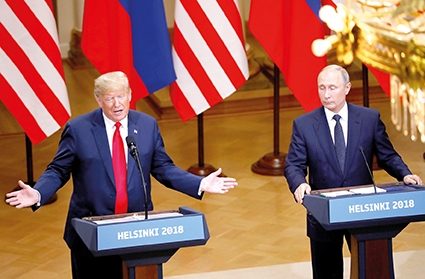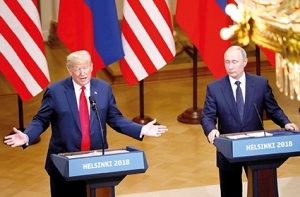America Still a Winner after the Helsinki Summit
In the lead-up to the July 15 Helsinki Summit between Putin and Trump, three countries in the Eurasian landmass were expecting the meeting with particular fear and concern. The first is Ukraine, which struggles with pro-Russian forces in the east of the country. However, the summit was hailed by many Russian analysts as well as politicians as not really bringing about any changes. In fact, the strongest expression of the unchangeable US stance on Ukraine after the summit was the “Crimea Declaration,” released by the Department of State on July 25, where Russian moves against Ukraine were once again ostracized. From the geopolitical point of view, this might not mean a lot, but it further commits Washington to its previous policy of non-recognition of Russian territorial gains.
The US also announced it would give Ukraine around $200m to strengthen the country’s defense capabilities. Though the Pentagon indicated that the funds would be for training, communications, medical, and other non-lethal operational needs, the timing of the decision is notable. Ukraine as a crucial component of the US containment.
Another theater in the former Soviet space is Georgia, a contested country between the West and Russia. Georgian officials were particularly worried that Trump might weaken support for the South Caucasian country amid Russia’s military pressure in the breakaway regions of Abkhazia and South Ossetia. The American response was productive, as the two-week-long US and Georgia-led Noble Partner military exercise started on August 1 near Tbilisi, the country’s capital. Over 3000 troops are taking part in the drills, including US military personnel and other participating nations such as France, Germany, Norway, Poland, Turkey, Ukraine and the United Kingdom. Knowing how the Russians are particularly sensitive to such moves in their neighborhood, the US move is undeniably directed at Russia.
On Syria, the US-Russian military cooperation was praised by Putin and Trump, while the Russian President intended to build on this “de-confliction” and engage the US military in joint work on the return of refugees. Following the summit, the idea was firmly turned down by the commander of US Central Command, General Joseph L. Votel. According to the general, there was simply no firm ground on which military cooperation with Russia in Syria can be strengthened.
Thus, following the Trump-Putin meeting, the US-Russian military cooperation in Syria limited itself to preventing raids by the pro-al-Assad forces into the territory east of the Euphrates, controlled by the US-backed Syrian Democratic Forces (SDF).
Even on the diplomatic front, Russian efforts were rebuffed and the invitation extended to the US to attend the latest meeting of the so-called “Astana Process” which was held in Sochi on July 30, was turned down by Washington.
Beyond the immediate US concerns around Syria, following the Trump-Putin meeting, Republican and Democratic US senators introduced legislation on Thursday to impose new sanctions on Russia. The bill will probably include restrictions on new Russian sovereign debt transactions, energy and oil projects and Russian uranium imports, and new sanctions on Russian political figures and oligarchs. It also expresses strong support for NATO and would require that two-thirds of the Senate vote in favor of any effort to leave the Alliance. This serves as yet another effort by lawmakers to punish Moscow over interference in US elections and its activities in Syria and Ukraine.
To further repudiate Trump’s claims at the Helsinki Summit, the heads of national intelligence, Homeland Security, the National Security Agency and the FBI stressed again that Russia was still attempting to undermine US democracy through various means.
Thus, these foreign policy moves clearly indicate that the Russia-US standoff is unlikely to diminish in the near future. The Trump-Putin Summit discussed in the global context shows that despite Trump’s willingness for cooperation with Moscow, real improvement is not coming. And so we enter an interesting period in world history when geopolitics in Eurasia is gradually shifting. Global trends in trade as well as military affairs dictate that the US has to continue on its path to contain Russia in the former Soviet space and the Middle East. However, the same global trends also make Washington wary as the country is gradually bracing for a more troublesome China, with the White House likely to try to find common ground with Russia to enlist the latter in its containment of China.
However, in 2018, this scenario is still a distant one. Russia in Eurasia poses a more immediate threat to US interests and the above-given measures introduced by Washington following the summit express the willingness of the US officials to pursue the containment of Russia. In other words, the summit might have been an offense to American prestige among the country’s allies across the globe, but the country nevertheless did not give up any essential point to the Russian side.
By Emil Avdaliani












